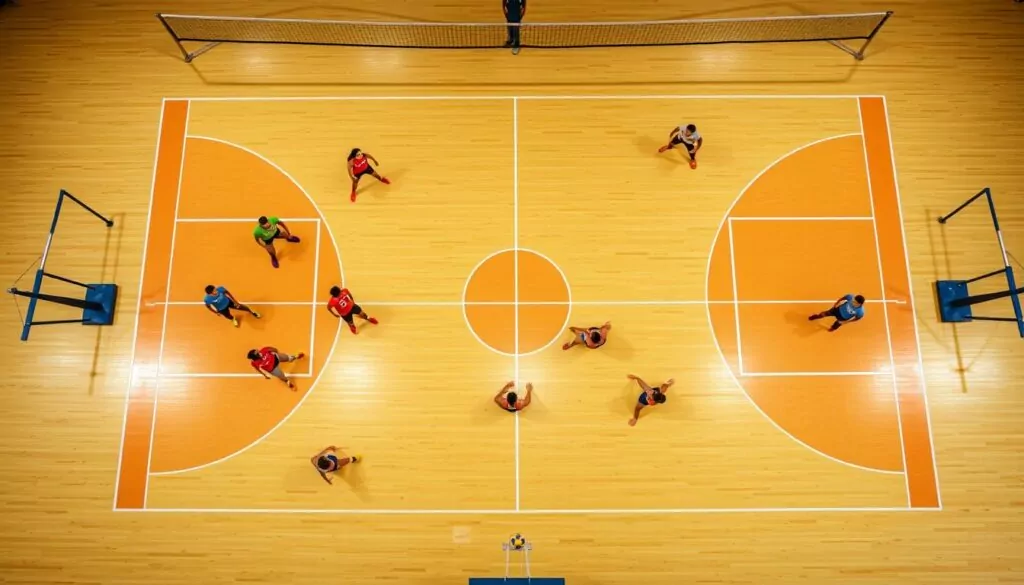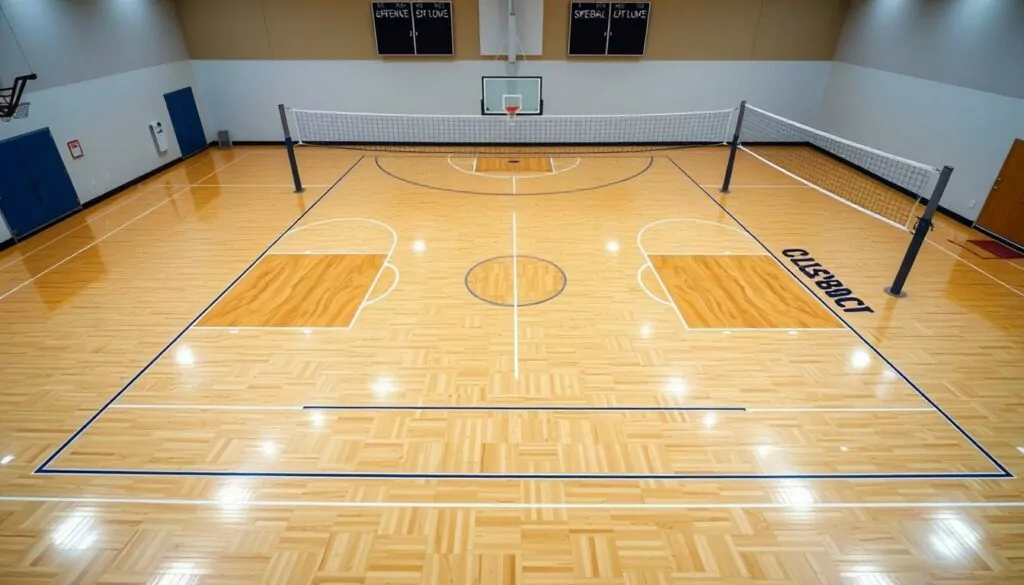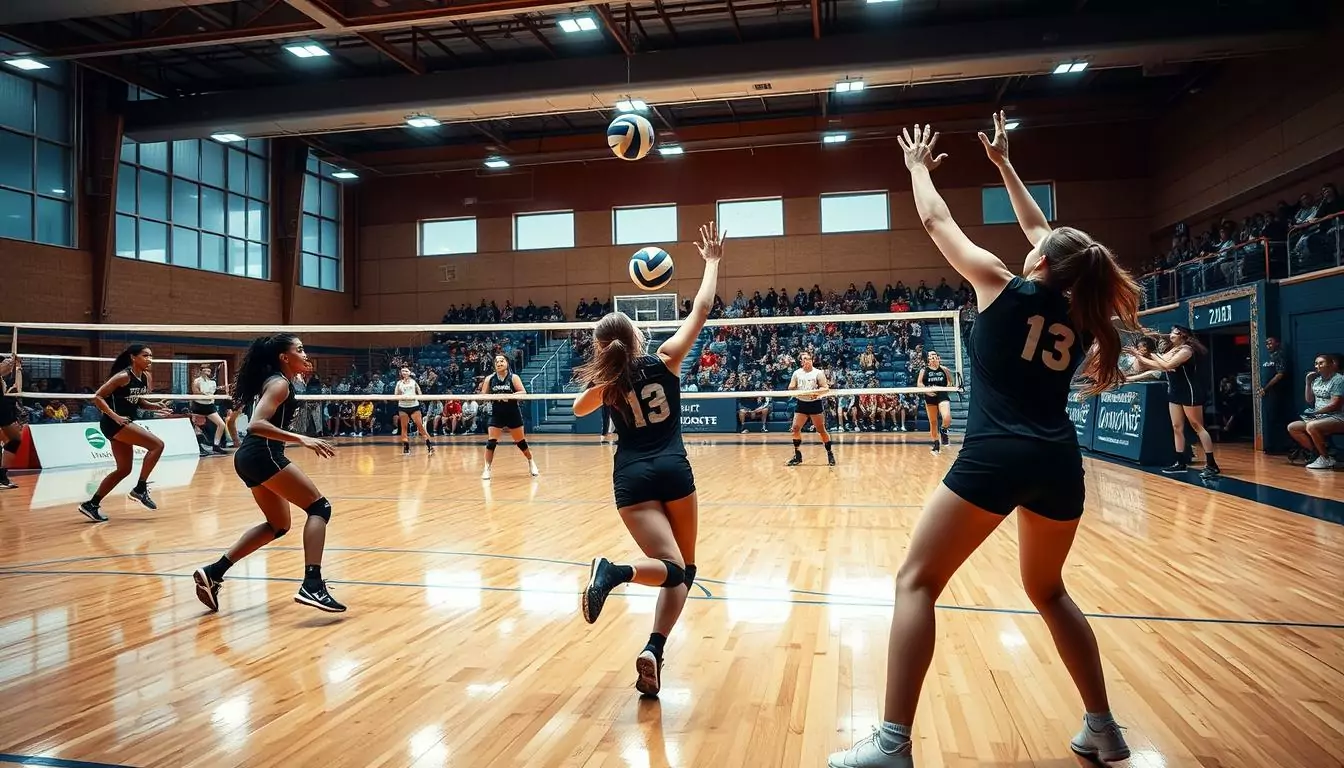I’ll never forget the day I stepped onto an indoor volleyball court for the first time. The squeak of shoes on polished wood, the crisp smack of the ball, and the electric energy of teammates working in unison. It was love at first serve. Whether you’re a newcomer or looking to polish your skills, this indoor volleyball guide is your ticket to mastering the game.
Volleyball rules and techniques might seem daunting at first, but I promise they’re easier to grasp than you think. From perfecting your serve to understanding rotations, we’ll cover it all. So lace up your shoes, and let’s dive into the world of indoor volleyball!
Key Takeaways
- Learn essential volleyball rules and court positions
- Understand scoring systems and player rotations
- Discover key volleyball techniques for serving, passing, and spiking
- Explore equipment needs and court setup
- Gain insights into advanced strategies and team formations
- Find tips for effective training and skill development
Volleyball Fundamentals: Your First Steps Into the Game

As an indoor volleyball guide enthusiast, I’m excited to share the basics of this thrilling sport. Volleyball combines strategy, teamwork, and athleticism, making it a fantastic game for players of all levels.
Basic Court Positions and Player Roles
In volleyball, each team has six players on the court. The positions are setter, outside hitter, opposite hitter, middle blocker, and libero. Each role is crucial for a team’s success. The setter orchestrates the offense, while hitters score points. Middle blockers defend at the net, and the libero specializes in back-row defense.
Essential Rules for Beginners
Understanding volleyball rules is key to enjoying the game. Here are some basics:
- Teams can touch the ball up to three times before sending it over the net
- Players can’t touch the net during play
- The ball must be hit, not caught or thrown
- Serves must be made from behind the end line
Scoring System and Rotations
Modern volleyball uses a rally scoring system. Points are awarded on every play, regardless of which team served. Games are typically played to 25 points, with a two-point lead needed to win. Teams rotate clockwise after winning a point on the opponent’s serve, ensuring all players get a chance to play different positions on the court.
Indoor court dimensions are important to know. A standard court measures 18 meters long and 9 meters wide, with a net height of 2.43 meters for men and 2.24 meters for women. Understanding these dimensions helps players position themselves effectively during gameplay.
Indoor Volleyball Guide: Equipment and Court Setup

Setting up for a volleyball game involves more than just grabbing a ball and hitting the court. I’ll guide you through the essentials of indoor court dimensions, volleyball equipment, and safety gear to prevent injuries.
Official Court Dimensions and Markings
An indoor volleyball court measures 18 meters long and 9 meters wide. The net height varies: 2.43 meters for men and 2.24 meters for women. Key areas include attack lines, end lines, and side lines. Understanding these markings is crucial for gameplay and positioning.
Choosing the Right Volleyball Gear
Selecting proper volleyball equipment is vital for performance and comfort. Here’s what you need:
- Volleyball: Choose a leather ball for indoor play
- Shoes: Look for good ankle support and cushioning
- Knee pads: Essential for floor dives and slides
- Comfortable clothing: Breathable fabrics work best
Safety Equipment and Protective Gear
Volleyball injuries can occur, but the right gear can help prevent them:
| Protective Gear | Purpose |
|---|---|
| Ankle braces | Prevent sprains during jumps and quick movements |
| Compression sleeves | Provide support and improve circulation |
| Finger tape | Protect fingers from jams and sprains |
By understanding court layout, choosing appropriate gear, and using protective equipment, you’ll be ready to enjoy volleyball safely and effectively.
Core Techniques for Successful Gameplay

Mastering volleyball techniques is crucial for success on the court. I’ll guide you through the essential skills every player needs to develop. Let’s dive into the core elements of volleyball training that will elevate your game.
Serving is the foundation of every play. To perfect your serve, focus on consistent toss height and contact point. Practice different types of serves to keep opponents guessing. Passing accuracy is key for setting up attacks. Keep your platform stable and move your feet to the ball.
Setting requires precise hand positioning and quick decision-making. Work on your fingertip control and court awareness. For attacking, timing is everything. Approach the net with power and aim for the corners of the court. Blocking is both an offensive and defensive skill. Jump straight up and reach over the net to shut down opposing hitters.
“Volleyball is not about individual skills; it’s about how well you can blend those skills with your teammates.” – Karch Kiraly
To improve these volleyball techniques, incorporate specific drills into your training routine:
- Wall passes for consistent ball control
- Partner setting to enhance accuracy
- Approach and hitting lines for power development
- Block footwork drills for quicker reactions
Remember, repetition is key in volleyball training. The more you practice these core techniques, the more natural they’ll become during gameplay. Focus on proper form first, then gradually increase speed and power.
| Technique | Key Focus | Common Mistake | Drill to Improve |
|---|---|---|---|
| Serving | Consistent toss | Arm swing too low | Target serving |
| Passing | Stable platform | Ball contacting arms | Pepper drill |
| Setting | Soft hands | Pushing ball | Wall sets |
| Attacking | Timing approach | Arm draw too early | Approach lines |
| Blocking | Penetration over net | Reaching across net | Block jumps |
Advanced Strategies and Team Formations
I’ve learned that mastering advanced volleyball strategies and formations can take your game to the next level. Let’s dive into some key concepts that will help you dominate the court.
Offensive Systems and Plays
Offensive volleyball strategies aim to keep the opposing team guessing. The 5-1 and 6-2 systems are popular choices. In a 5-1, one setter controls the offense, while a 6-2 uses two setters. These formations allow for diverse attack options and flexibility in player positioning.
Defensive Formations and Coverage
Strong defense is crucial in volleyball. The perimeter defense is a common formation where players form a U-shape around the court. This setup allows for quick reactions to spikes and serves. Effective communication and quick transitions between offense and defense are key to successful volleyball techniques.
Serving Strategies and Variations
Serving is more than just getting the ball over the net. Mastering different serves can throw off your opponents. Jump serves, floaters, and topspin serves are essential volleyball techniques to practice. Varying your serve placement and power keeps the receiving team off-balance.
| Serve Type | Description | Best Used |
|---|---|---|
| Jump Serve | Powerful serve with a running start and jump | To apply pressure on weak passers |
| Floater | Serve with minimal spin, unpredictable trajectory | To create confusion for receivers |
| Topspin | Serve with forward rotation, dips sharply | To target gaps between players |
Incorporating these advanced volleyball strategies into your volleyball training regimen will significantly improve your team’s performance. Remember, consistent practice and teamwork are key to executing these techniques effectively on the court.
Training Programs and Skill Development
I’m excited to share some effective volleyball training techniques to help you improve your game. A well-rounded training program combines conditioning, individual drills, and team activities. Let’s dive into each aspect to boost your skills on the court.
Conditioning Exercises for Volleyball
Volleyball demands strength, agility, and endurance. I recommend incorporating these exercises into your routine:
- Jump rope for improved footwork
- Squats and lunges for leg power
- Planks for core stability
- Sprints for quick bursts of speed
Individual Practice Drills
To excel in volleyball, you need to master fundamental techniques. Try these volleyball drills to enhance your skills:
- Wall passing to improve ball control
- Serving practice for accuracy and power
- Setting drills using a target
- Spiking against a wall for timing and technique
Team Building Activities
Volleyball is a team sport, so building trust and communication is crucial. Here are some team activities to try:
| Activity | Purpose | Duration |
|---|---|---|
| Blind Volleyball | Improve communication | 20 minutes |
| Partner Passing Challenge | Build trust and coordination | 15 minutes |
| Team Strategy Sessions | Enhance tactical understanding | 30 minutes |
By incorporating these volleyball training elements into your practice sessions, you’ll see improvements in your individual skills and team performance. Remember, consistency is key in mastering volleyball techniques!
Conclusion
As we wrap up this indoor volleyball guide, I hope you’ve gained valuable insights into the game’s fundamentals, strategies, and techniques. From mastering basic court positions to implementing advanced volleyball strategies, every aspect plays a crucial role in your development as a player.
Remember, becoming proficient in volleyball requires dedication and consistent practice. The skills and knowledge you’ve acquired through this guide serve as a solid foundation, but your journey doesn’t end here. Keep refining your techniques, experimenting with different volleyball strategies, and working on your physical conditioning to elevate your game.
For those looking to deepen their understanding of the sport, consider exploring volleyball officiating opportunities. Becoming a certified referee or line judge can provide a unique perspective on the game’s intricacies. This knowledge can significantly enhance your playing experience and contribute to the volleyball community.
Whether you’re stepping onto the court for the first time or aiming to refine your skills, this indoor volleyball guide is your companion on the path to success. Embrace the challenges, celebrate your progress, and enjoy the thrill of the game. Now, it’s time to put your knowledge into action and make your mark on the volleyball court!
